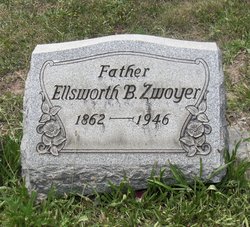After World War I, he started Zwoyer Fuel Co. and made briquettes at plants in Buffalo, N.Y., and Fall River, Massachusetts
In 1927, Zwoyer patented a "Briquetting Method" and "Method of Carbonizing Fuel Briquettes."
A victim of the Great Depression, Zwoyer moved his family to Illinois.
Before Ford and Kingsford, there was Ellsworth B.A. Zwoyer of Reading.
Zwoyer invented and patented the charcoal briquette in 1897, more than 20 years before Ford got into the business, according to records in the U.S. Patent Office.
He filed two patents in May 1897 and, on Aug. 3, 1897, the U.S. Patent Office issued patent Nos. 27,483 and 27,484 to Zwoyer. The patents were good for 14 years.
"Be it known that I, Ellsworth B.A. Zwoyer, a citizen of the United States and resident of the city of Reading, Berks County, Pennsylvania, have invented and produced a new and original design for lumps of fuel," he wrote in a statement accompanying the patent.
The inventor described his design as "truncated pyramids with rounded corners and slightly rounded or convex tops" - pretty much a prototype for what briquettes look like today.
The design, charted in drawings submitted with the patent application, was witnessed by D.C. Boyer and R.J. Boyer.
Zwoyer's connection to Reading, other than having been a resident when the patents were issued, remains somewhat of a mystery.
Boyd's City Directory for 1897, the year the patents were issued, lists Zwoyer as a machinist living at 1006 N. 10th St.
The 1900 City Directory lists his employer as Davies Printz Co., machinists and brass and iron founders, at 223-231 S. Ninth St.
http://www2.readingeagle.com/article.aspx?id=382083
Information provided by FAG member 48594125
After World War I, he started Zwoyer Fuel Co. and made briquettes at plants in Buffalo, N.Y., and Fall River, Massachusetts
In 1927, Zwoyer patented a "Briquetting Method" and "Method of Carbonizing Fuel Briquettes."
A victim of the Great Depression, Zwoyer moved his family to Illinois.
Before Ford and Kingsford, there was Ellsworth B.A. Zwoyer of Reading.
Zwoyer invented and patented the charcoal briquette in 1897, more than 20 years before Ford got into the business, according to records in the U.S. Patent Office.
He filed two patents in May 1897 and, on Aug. 3, 1897, the U.S. Patent Office issued patent Nos. 27,483 and 27,484 to Zwoyer. The patents were good for 14 years.
"Be it known that I, Ellsworth B.A. Zwoyer, a citizen of the United States and resident of the city of Reading, Berks County, Pennsylvania, have invented and produced a new and original design for lumps of fuel," he wrote in a statement accompanying the patent.
The inventor described his design as "truncated pyramids with rounded corners and slightly rounded or convex tops" - pretty much a prototype for what briquettes look like today.
The design, charted in drawings submitted with the patent application, was witnessed by D.C. Boyer and R.J. Boyer.
Zwoyer's connection to Reading, other than having been a resident when the patents were issued, remains somewhat of a mystery.
Boyd's City Directory for 1897, the year the patents were issued, lists Zwoyer as a machinist living at 1006 N. 10th St.
The 1900 City Directory lists his employer as Davies Printz Co., machinists and brass and iron founders, at 223-231 S. Ninth St.
http://www2.readingeagle.com/article.aspx?id=382083
Information provided by FAG member 48594125
Family Members
Sponsored by Ancestry
Advertisement
Advertisement











